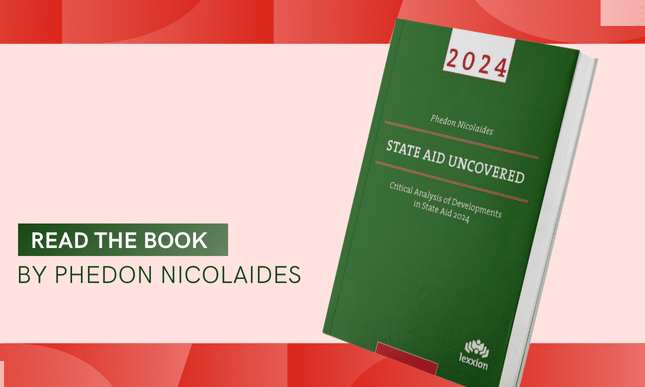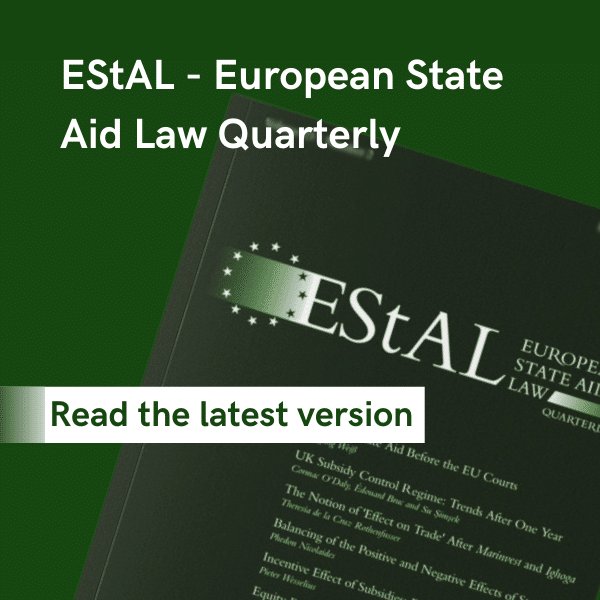
Introduction
Background
The intriguing background to this case is described in detail in Commission Decision 2014/201 on compensation that was proposed to be paid to bus company Simet for public transport services provided between 1987 and 2003.[1]
In May 2011, Italy notified a measure that described how compensation was to be granted to Simet for the provision of inter-regional bus transport services. Allegedly, Simet was under a public service obligation during the period 1987–2003 and the Council of State (Consiglio di Stato) – Italy’s Supreme Administrative Court – ordered that Simet should receive compensation.
Simet is a private company providing scheduled passenger transport services by bus based on concessions granted by the Italian authorities. In addition to these services, which account for approximately two thirds of its revenue, Simet also provides other services, including international travel services, tourism services and bus hire with driver, which account for the remaining third of its revenue.
Simet, like other providers of inter-regional scheduled bus services, operates on the basis of licences (concessions) which are renewed annually at the request of the company. Those concessions give the company the exclusive right to provide the relevant services. The concession in question stated that delivering the service did not give the company the right to any subsidy or compensation of any kind, and that the service was operated entirely at the company’s own risk. The fares proposed by the company itself were also reflected in the annual concession specifications accepted by the Ministry for Infrastructure and Transport.
In October 1999, for the first time Simet asked the Ministry for compensation for its inter-regional bus services. The Ministry denied this and the subsequent requests, as it considered that it had not entrusted Simet with public service obligations.
In response to the Ministry’s refusal to grant public service compensation, Simet brought a legal action before the Italian administrative courts. On appeal, the Council of State recognised Simet’s right to receive compensation for the scheduled bus services provided under the concessions. Following this judgment and before granting any compensation, Italy decided to notify the measure to the Commission.
The Commission opened the formal investigation procedure because it doubted that the compensation was not State aid [in compliance with the Altmark criteria]. It also had doubts on the compatibility of the aid with the internal market. In other words, the Italian authorities obtained what they wished for.
Existence of aid
The Commission found that the proposed compensation constituted State aid. It was funded by state resources, it was selective and, given the fact that bus transportation is a service that is open to all bus operators in the EU, it was also capable of affecting trade and distorting competition. The disputed issue was whether the compensation conferred an advantage to Simet.
According to the Altmark judgment, compensation that satisfies certain criteria is not State aid. The Commission summarily (and correctly) concluded that the proposed compensation did not satisfy all of the Altmark criteria and, therefore, the proposed compensation was State aid.
More specifically, the Commission considered that the second Altmark criterion did not apply in this case. “The need to establish the compensation parameters in advance does not mean that the compensation has to be calculated on the basis of a specific formula. Rather, what matters is that it is clear from the outset how the compensation is to be determined” [paragraph 93].
In the case of Simet, no such parameters were ever established in advance in an objective and transparent manner. This meant that compensation calculations were necessarily based solely on ex post estimates of the net costs. It is clear that the Commission applies strictly the requirement for ex ante determination of compensation parameters.
Compatibility of the aid
After considering and dismissing the claim that Regulation 1191/69 could apply to this case, the Commission then proceeded to examine whether the aid was in conformity with Regulation 1370/2007 on public service contracts for passenger transport by road and by rail, and concluded that for the following reasons it was not.
First, the concession specifications stipulated that the operation of the services did not give Simet any right to a subsidy or compensation of any kind and that the service was operated entirely at the company’s own risk. This exclusion of compensation necessarily entailed that the compensation parameters were not established in advance, as required by Regulation 1370/2007.
Second, Simet did not apply proper account separation. Consequently, it was impossible to demonstrate that compensation did not exceed the amount corresponding to the net financial effect of the public service obligation on the costs and revenues of Simet.
Third, in the absence of compensation parameters laid down in advance, any cost allocation would necessarily be conducted ex post on the basis of arbitrary assumptions.
Do you know we also publish a journal on State aid?

The European State Aid Law Quarterly is available online and in print, and our subscribers benefit from a reduced price for our events.
Fourth, the Commission did not accept the derived costs which were based on the assumption that in each year all services provided by Simet had to bear costs which were in the same proportion as their revenues.
Fifth, an ex post calculation would “necessarily result in full compensation of the costs incurred in the provision of the service”. The Commission considered that a rate of return on equity exceeding the relevant swap rate plus 100 basis points “would normally not be viewed as a suitable reference for calculating the reasonable profit” [paragraph 129].
It should be noted that the fourth and the fifth points are probably the most relevant also for other cases of public service compensation. Ex-post allocation of costs and ex-post compensation removing all risk are compatible neither with Regulation 1370/2007 nor with the 2012 SGEI Framework that applies to all sectors other than transport.
Lastly, the Commission addressed Simet’s argument that the Italian courts ordered the Italian state to compensate it. It maintained that “an award of damages in favour of Simet for the alleged illegal unilateral imposition of public service obligations by the Italian authorities, […] would contravene Articles 107 and 108 of the Treaty. This is because such an award would produce the exact same result for Simet as an award of public service compensation […] The availability of such an award would thus effectively enable the circumvention of State aid rules and the conditions laid down by the Union legislator under which competent authorities, when imposing or contracting for public service obligations, compensate public service operators for costs incurred in return for the discharge of public service obligations” [paragraph 132]. It is then clear that national laws and procedures cannot produce results that would be contrary to EU rules on State aid.
In light of the above, the Commission found that the measure constituted State aid according to the meaning of Article 107(1) of the Treaty, and that the aid was incompatible with the internal market. No recovery was ordered because no aid had been granted.
The Annex below explains in more detail how the compensation was calculated. Since this was done ex-post, it was rejected by the Commission. However, had it been done ex-ante, it is likely that it would have been accepted by the Commission. Specifically, the calculations provide useful guidance on how to separate costs, how the parameters of compensation can be determined and how expected profit can be estimated ex-ante.
Annex: Method for estimating eligible costs
Since no analytical accounts were kept by Simet for the relevant period, the costs of the bus services in question were allocated on the basis of the percentage of revenue generated by the same services during that relevant period.
The total amount of costs was calculated from each of the annual financial statements. Then, in order to reconstruct the operating costs, the following non-operating costs were deducted from total costs:
- Payable interest;
- Financial charges;
- Losses on disposal of assets;
- Miscellaneous losses and costs;
- Direct taxes;
- Final inventories;
As explained above, the operating costs attributable to the bus services were determined on the basis of the percentage of revenue generated by the same scheduled bus services.
For certain years cost accounting data were available. Costs were divided in the following categories:
- Costs related to mileage;
- Costs directly allocable to scheduled bus services;
- Allocable costs based on turnover.
The first category of costs includes costs related to fuel, engine oil, tyres, spare parts, outside work, vehicle wash, motorway tolls, compulsory vehicle servicing, leasing and depreciation of assets. Each of these cost items was divided by the total number of kilometres travelled and the cost per kilometre was then multiplied by the number of kilometres travelled by scheduled bus services only.
The second category of costs includes those cost items which, on the basis of the analytical accounts, are directly attributable to inter-regional scheduled bus services. These include: direct employment, waste disposal, commissions payable, miscellaneous charges, parking fees, rental of third-party vehicles for scheduled bus services, purchases for on-board services, and reimbursement of travelling personnel’s expenses.
The third category of costs includes ‘indirect costs’ and comprises indirect labour costs, overheads, bus insurance, vehicle ownership tax and rent for premises. Those costs were allocated on the basis of the percentage of revenue generated by the same scheduled bus services.
After adding up the figures calculated for the relevant periods, the total costs related to the scheduled bus services were found to amount to EUR 59,510,413.
Consequently, after subtracting these costs from the revenues derived from scheduled bus services, it was found that there was an operating loss of EUR 2,296,973.
The compensation had to be increased by an amount corresponding to “reasonable profit” or the required remuneration of the capital employed. This was calculated as follows:
For each year, the capital employed was the sum of:
- Equity (E), whose value was taken from the annual financial statements, considering the shareholder’s equity and
- Loan capital (D). Loan capital was only financial debt, i.e. payables to banks and to other lenders.
The Weighted Average Cost of Capital (WACC) formula was used to determine the remuneration rate of the capital employed:
WACC = Re(E/V) + Rd(D/V)(1 – Tc), where
Re = required rate of return on equity
Rd = cost of debt
E = firm’s equity
D = firm’s debt
V = E + D
E/V = percentage of financing that is equity
D/V = percentage of financing that is debt
Tc = corporate tax rate
The required return on equity was calculated using the Capital Asset Pricing Model. This model describes the relationship between risk and expected return:
Re = Rf +b(Rm – Rf), where
Rf = risk-free rate or return
B = beta [a measure of the volatility or specific risk of a share in comparison to the market as a whole]
Rm = expected market rate of return
The interest rate for ten-year government bonds, taken from national statistics, was used as a proxy for the risk-free rate Rf. A risk premium (Rm – Rf) of 5.8% was on average asked by investors investing in stocks rather than in risk-free securities on the Italian market.
The beta of the shares in Simet’s capital was calculated by taking an unlevered beta [unlevered beta = beta of the company without any debt] value of 0.39 for the bus service and transport sector. That beta value was subsequently adjusted relative to the financial structure reported by the company for each year:
Levered beta = Unlevered beta x {1 + [(1 – Tax Rate) x (Debt/Equity)]}
From 1987 to 1994 the Italian corporate tax rate was 36%, from 1995 to 2000 it was 37%, and from 2001 to 2002 it was 36%.
The remuneration of capital employed provides the compensation that Simet should receive after tax. As the compensation is taxable, it has to be adjusted as follows:
Remuneration before tax = Remuneration after tax ÷ (1−corporate tax rate)
On the basis of these formulas, the remuneration for the capital employed by Simet was EUR 5,948,150.
Thus, the total amount of compensation before the application of late payment interest was EUR 8,245,124 (compensation related to the operating loss [EUR 2,296,973] and remuneration of the capital employed [EUR 5,948,150]).
Calculation of interest for late payment
Given that the compensation sums calculated above were not paid in the years for which they were due, those sums were revised upwards as follows: The sums initially calculated were re-valued according to consumer price inflation indices up to July 2012. Then statutory interest was applied to the derived amounts. Consequently, the total compensation was EUR 22,049,796.
[1] OJ L114, 16/4/2014. The text of the Decision can be accessed at:
http://eur-lex.europa.eu/legal-content/EN/TXT/?uri=uriserv:OJ.L_.2014.114.01.0048.01.ENG



